Mastering Ribeye Cooking Techniques for Perfect Steak
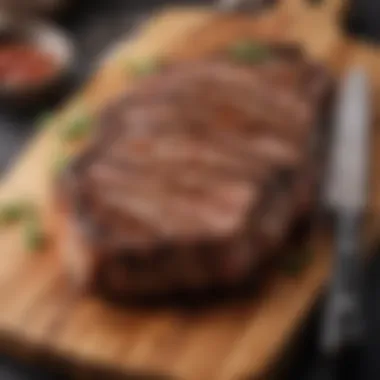
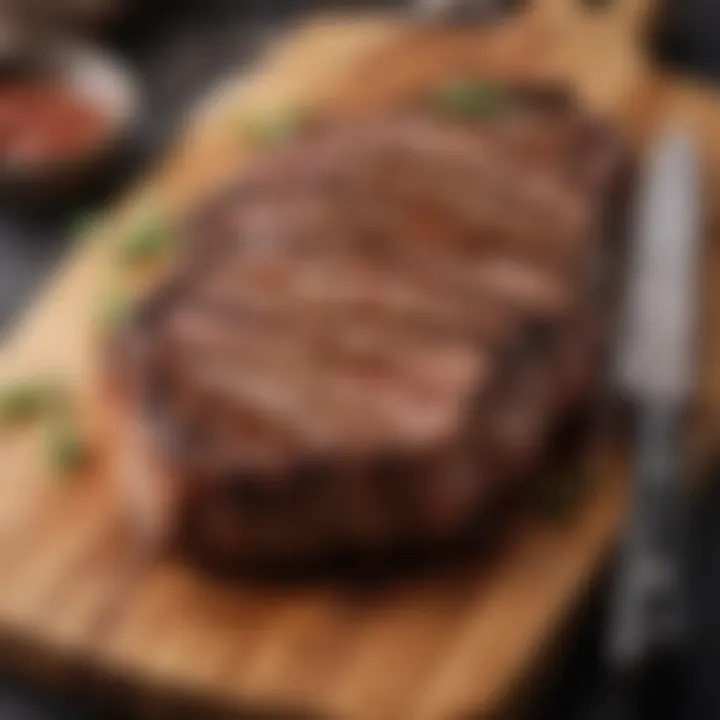
Intro
Cooking a ribeye steak is not just about throwing a piece of meat on a grill and hoping for the best. It’s an art that combines deft techniques with an understanding of flavor principles. Whether you’re a seasoned chef or just starting out on your culinary journey, mastering the ribeye can elevate your cooking repertoire. This guide aims to demystify the entire process, from choosing the best cut at the butcher shop to the final touches before serving.
Recipe Overview
- Recipe name: Perfectly Pan-Seared Ribeye
- Brief description of the dish: The perfect ribeye is juicy, well-seasoned, with a beautiful crust. Searing in a hot pan locks in the moisture while developing that irresistible Maillard reaction flavor.
Ingredients List
Main ingredients
- 1 ribeye steak, about 1 to 1.5 inches thick
- Kosher salt
- Freshly ground black pepper
- 2 tablespoons of olive oil or unsalted butter
- Fresh herbs like rosemary or thyme (optional)
Optional ingredients
- Garlic, smashed or whole
- A splash of red wine or broth for deglazing
- A dollop of compound butter for serving
As we delve deeper into the nuances of cooking ribeye, the focus will be on selecting high-quality ingredients and applying the right techniques to achieve that perfect cook. Drawing from traditional methods and modern practices, this guide will equip you with a well-rounded skill set to tackle your ribeye steak with confidence.
"The secret to great steak lies not in the cut, but in the care taken to prepare it."
We’ll walk through each stage of preparation, ensuring that even novice cooks can gain the confidence to create a steak that rivals fancy steakhouse offerings. Get ready to explore flavor profiles, seasoning techniques, and cooking methods that are sure to impress even the most discerning palates.
Prelims to Ribeye Steak
Ribeye steak, often regarded as a star of the culinary world, has carved out a prominent place on the plates of meat aficionados. This section sets the stage for understanding why ribeye isn’t just any cut of beef, but rather a culinary delight that captivates both seasoned chefs and home cooks alike. It’s essential to appreciate the depth of flavor, tenderness, and versatility that ribeye offers, which makes it a favored choice in steakhouses and kitchens around the globe.
Understanding Ribeye: A Culinary Delight
At its core, ribeye steak combines rich marbling with robust beefy flavor, showcasing everything that makes beef an ingredient of choice for so many. The unique marbling—those streaks of fat running through the meat—melts during cooking, infusing the steak with juiciness and a depth of flavor that is hard to beat. Unlike leaner cuts, ribeye brings an unparalleled taste experience to the table.
The culinary uses of ribeye are vast, ranging from classic grilling scenarios to more nuanced sous-vide applications. It caters to a wide array of personal preferences, effortlessly accommodating everything from a simple salt and pepper seasoning to more adventurous spice blends and marinades. Each method of preparation highlights the steak’s qualities, allowing cooks to flex their culinary muscles.
Ribeye truly shines in its ability to turn a regular meal into something extraordinary. Whether you're enjoying it at a casual cookout or a formal dinner party, the flavor profile delivers satisfaction that resonates with food lovers across all ages.
The Anatomy of a Ribeye
A good understanding of what makes up a ribeye steak is critical for anyone looking to perfect their cooking technique. Ribeye is cut from the rib section of the cow, specifically from the upper midsection, which is where the meat is tender and infused with flavor from surface fat and muscle. When you look at a ribeye, you might notice two main components:
- The Eye: This is the main portion of the ribeye that’s incredibly tender and flavorful, often referred to just as the “eye of ribeye.” Its texture is buttery and almost melts in your mouth.
- The Cap: Known as the spinalis dorsi, this outer layer of meat has an even higher fat content than the eye. It’s prized for its rich taste and tenderness, offering a restaurant-quality experience when cooked correctly.
When choosing a ribeye, seeking out steaks with a generous marbling pattern ensures you get the most flavorful cut. The balance of fat and meat isn’t just aesthetically pleasing; it is key to achieving that mouthwatering taste we all seek. Additionally, ribeye does well with both high-heat methods, such as grilling, and slower cooking methods like braising. Understanding this anatomy helps in making informed decisions about cooking methods and flavor pairings.
"A great ribeye steak isn’t just about the cooking; it’s about the appreciation of meat in its finest form."
With a solid foundation on what ribeye is and how it’s structured, you stand ready to delve into selecting the right cut, mastering preparation methods, and refining your cooking techniques. This knowledge will pave the way for an enjoyable cooking experience, leading to ribeye dishes that will not only impress but become cherished recipes in your culinary repertoire.
Selecting the Right Ribeye
Choosing the right ribeye is almost like going treasure hunting—it requires patience, an eye for quality, and a sense of what suits your taste. In this guide, we’ll dissect everything you need to know to ensure you're selecting a cut that will not only meet but exceed your expectations, setting the stage for a mouthwatering experience.
Why does the cut matter so much? Well, ribeye steaks are renowned for their robust flavor and tender texture, but these qualities can vary significantly based on several key factors. Understanding these factors will not only elevate your cooking but also enrich your culinary journey.
Grass-Fed vs. Grain-Fed
One of the first questions that comes to mind when selecting ribeye is whether to go for grass-fed or grain-fed beef. Each has its own charm. Grass-fed beef is usually leaner and tends to boast a more robust, earthy flavor; some say it has a better texture as well. On the flip side, grain-fed beef is often more marbled with fat, leading to a juicier steak with a sweeter taste profile.
- Grass-Fed
- Grain-Fed
- Leaner with a distinct flavor
- Often more environmentally sustainable
- May have a slightly chewier texture
- Richly marbled and soft
- Tender and juicy, with a subtle sweetness
- Commonly found in steakhouses
It really comes down to personal preference. If you prefer a steak that melts in your mouth, you might want to lean toward grain-fed. If you’re after a more distinct flavor that says "grass and sunshine," then consider the grass-fed option.
Choosing the Best Marbling
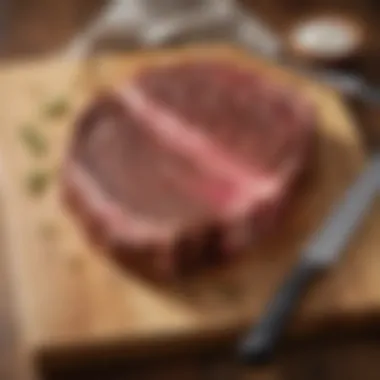
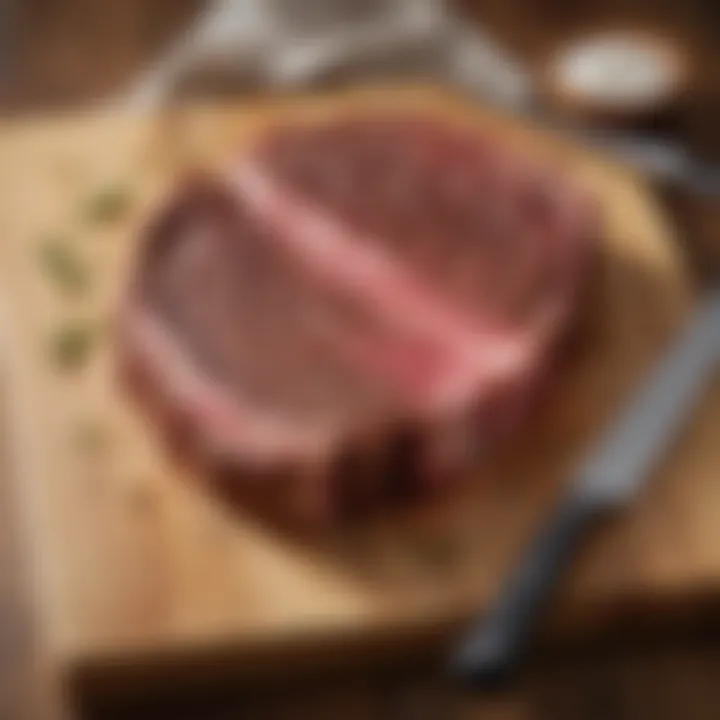
Next up is marbling—the small streaks of fat running through the meat. This is crucial, as it significantly impacts flavor and tenderness. Imagine a beautiful ribeye: the more marbled it is, the more flavorful it becomes during cooking.
- Increased Flavor: As the fat melts, it bastes the meat, adding richness.
- Enhanced Moisture: Marbling helps keep the steak juicy, avoiding that dreaded dryness.
- Visual Appeal: A well-marbled cut is not only delicious but also looks stunning on the plate.
When inspecting the ribeye, look for those white flecks interspersed throughout the red meat. This is your indication of quality. Just keep in mind, too much fat can be counterproductive, leading to a greasy experience.
Thickness and Size Considerations
Last but not least, let’s talk about the thickness of your selected ribeye. Ideally, you want your steak to be at least one inch thick, allowing for a perfect sear while keeping the inside nice and medium-rare. But then again, who’s to say you can’t treat yourself to a thicker cut?
- Thickness Matters: A thicker steak holds onto heat better, giving you a juicy result.
- Serving Sizes: Consider who you’re cooking for—larger crowds might require larger cuts, while a quiet dinner for two can be satisfied with a more modest size.
When you're shopping, ask your butcher for recommendations. They can offer insights about the best cuts they have on hand, guiding you to the ribeye that would ultimately grace your plate.
By keeping these details in mind, you’re well on your way to honing in on the ideal ribeye, setting the foundation for a delightful cooking experience.
Preparation Methods
Preparation methods are the bedrock upon which a delicious ribeye steak is built. Without the right prep work, even the finest cut of meat can fall flat. This section sheds light on the vital aspects, as we dive deep into seasoning, marinades, and the importance of tempering our steak.
The Importance of Seasoning
Seasoning is often considered an afterthought, yet it’s one of the most crucial elements in cooking. Salt is not just to taste; it's a game changer that can enhance the inherent flavors of the ribeye. When you sprinkle salt on the meat, it draws moisture to the surface which helps create that coveted crust when you cook. This is not just a dash and go — a good rule of thumb is to season your steak liberally, letting it sit for a good 40 minutes before cooking.
The key is to find the right balance. Too little seasoning and the rich flavors of the ribeye won’t shine through. Too much, and you’ll overpower that natural taste. Different varieties of salt can also provide unique flavor profiles — consider trying kosher salt for its coarse texture or Maldon sea salt for a flaky finish that crunches delightfully when bitten.
Marinating vs. Dry Rubs
Choosing between marinating and dry rubs can sometimes feel like comparing apples and oranges. Both methods have their merits depending on the texture and flavors you aim for.
- Marinating involves soaking the steak in a liquid solution, typically composed of acid (like vinegar or citrus), oil, and seasonings. This method tenderizes the meat while infusing it with robust flavor. A common marinade might include soy sauce, garlic, and a splash of red wine — rich and savory, absolutely mouthwatering.
- Dry rubs, on the other hand, are all about building a crust that packs a flavorful punch. A good dry rub combines spices, herbs, and seasonings rubbed directly onto the meat, creating a delicious exterior once cooked. If you lean towards a dry rub, consider using spices like smoked paprika, cumin, and brown sugar for a nice caramelization.
- The marinating time varies, with 30 minutes being the minimum and up to 24 hours for maximum flavor impact. But be cautious; too long in an acidic marinade can lead to an overly mushy texture.
So, which one to choose? It really boils down to how you like your steak. Want it to be bold and simple on the outside but rich inside? Go for a rub. Fancy a tender, flavor-infused bite? Marinate that ribeye.
Bringing the Steak to Room Temperature
Taking your steak out of the fridge a good 30 to 60 minutes before cooking is often overlooked yet essential. Allowing your ribeye to come to room temperature ensures it cooks evenly. If you toss a cold steak straight onto a hot grill, you'll end up with a beautifully seared outside and cold, chewy meat on the inside — not the heavenly delight we desire.
Furthermore, at room temp, the meat fibers begin to relax, which promotes tenderness when cooked.
- Cooking times also reduce when you start with a warmed steak, enhancing the overall experience because the meat won’t be sitting on the grill forever.
Taking those few extra moments to prepare your ribeye properly is what will make the difference between a good steak and an unforgettable steak. So, make it a point to treat your ribeye with the respect it deserves before firing up the grill.
"Preparation is a critical step that paves the way for an exceptional dining experience".
Embrace each of these preparation methods, and you’ll not only enhance your cooking skills but also ensure each ribeye turns out nothing short of spectacular.
Cooking Techniques
Cooking techniques play a pivotal role in the overall success of preparing ribeye steak. The various methods available each bring their own unique touch, allowing cooks to adapt their approach based on preferences, equipment, and desired flavors. Understanding these techniques can mean the difference between a steak that merely satiates and one that truly delights.
Grilling, pan-searing, sous vide, and oven finishing are some of the key methods that can extract the most flavor from a ribeye. Each approach offers its own benefits, whether it be the char from grilling, the rich crust formed by pan-searing, the precision of sous vide, or the gentle heat of the oven. The choice of technique should also consider equipment on hand; not everyone has access to a grill or sous vide setup, yet a delicious ribeye can still be achieved using a regular pan or oven.
Grilling Ribeye: Achieving the Perfect Sear
Grilling a ribeye steak is akin to stepping onto a culinary stage; the moments leading up to that perfect sear are where the magic happens. The intense heat of the grill caramelizes the meat's exterior, creating an alluring crust that seals in the juices. When grilling, ensure the grill grates are adequately preheated. A moment's hesitation can lead to a steak that sticks, risking tears in the meat.
Key Considerations for Grilling:
- Temperature: Aim for high heat to achieve that coveted sear.
- Clean Grill Grates: Before placing your ribeye on the grill, scrape the grates to avoid sticking.
- Timing: Use a timer to flip the steak just once, allowing it to sit undisturbed for optimal sear.
Pan-Searing: A Method for All Seasons
Pan-searing ribeye is a technique that showcases the flexibility of home cooking. This method involves cooking the steak in a hot cast iron or stainless steel pan, which provides excellent heat retention and promotes even cooking. As the fat in the ribeye melts, it enriches the pan, allowing for a beautiful fond to form—perfect for creating sauces.
- Heat: Start with medium-high heat to achieve a nice crust.
- Butter Basting: Towards the end of cooking, add a few tablespoons of butter to the pan. Use a spoon to baste the steak as it finishes cooking—this adds flavor and moisture.
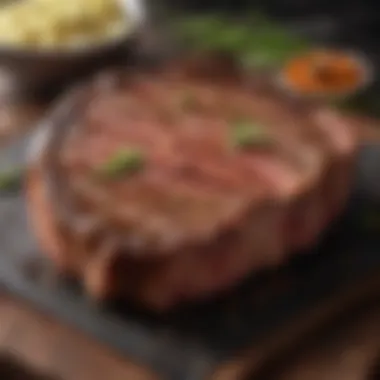
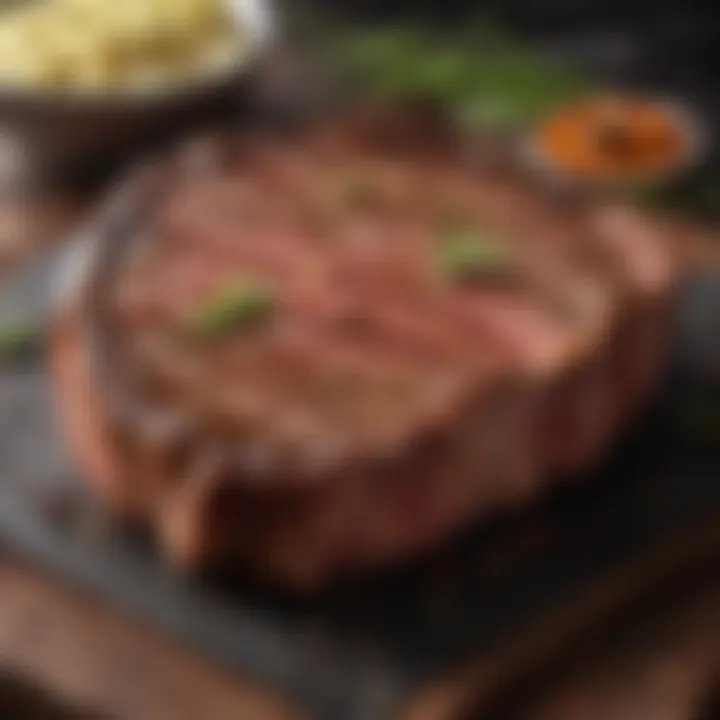
Sous Vide: Precision Cooking for Ribeye
Sous vide cooking is like giving your ribeye a warm, loving hug, slowly bringing it up to the perfect temperature. Cooking sous vide involves sealing the steak in a vacuum bag and immersing it in a water bath heated to the desired doneness. This method offers unparalleled control, ensuring even cooking throughout the entire steak.
- Technique: Set the immersion circulator to your target temperature (e.g., 130°F for medium-rare) and cook the steak for 1-4 hours.
- Finishing Touch: After sous vide cooking, quickly sear the ribeye in a hot pan or on the grill to create that necessary crust.
Oven Finishing for a Perfect Cook
Finishing ribeye steak in the oven is particularly helpful when dealing with thicker cuts or larger portions. This method allows for gradual cooking, preventing the steak from drying out while achieving a desirable internal temperature. Start by searing the steak on the stovetop to develop flavor, then transfer it to a preheated oven.
- Temperature: A temperature of about 400°F works well.
- Use a Meat Thermometer: Ensure that you pull the steak out just below the target temperature, as it will continue to cook while resting.
The journey of cooking ribeye varies, but the rewards are well worth the effort—unlocking flavors and textures that can transport your palate.
Each cooking technique has its merits, and whether grilling up a storm on a sunny afternoon or searing in the warmth of your kitchen during winter, mastering these methods will undoubtedly set you on the path to delicious ribeye success.
Achieving Desired Doneness
In the grand culinary scheme, achieving the perfect doneness of ribeye steak stands as one of the most critical elements in elevating your dining experience. It's not just about how you cook; it's about how that steak aligns with your palate's desires. The right degree of doneness ensures that all the flavor and juice is locked in, creating a sensory delight that sparks joy to anyone who sits down to enjoy it.
When we talk about doneness, we don't mean just a bunch of technical terms floating around. It's a dance between temperature and texture, an interaction that can impress or disappoint with just the slightest error. Understanding this concept allows you to tailor the cooking process to your preference, whether that’s a juicy medium-rare or a more cooked medium.
The benefits of mastering steak doneness include the ability to serve a ribeye that’s not only visually appealing but also optimally tender and juicy. Moreover, getting doneness just right can elevate your skills, making you the go-to cook—be it for family gatherings or friendly barbecues. Now, let's dive into the specifics of how to tell if your ribeye is cooked just the way you like it.
Understanding Different Levels of Doneness
Cooking steak can feel like navigating a minefield where every explosion spells disaster if you misstep. Yet, once you grasp the varying levels of doneness, you’ll find yourself on solid ground. Here’s a quick rundown:
- Rare: For those who enjoy steak as red as a summer sunset, rare ribeye comes in at about 120-125°F. It’s soft and has a cool center.
- Medium-Rare: A favorite among steak aficionados, medium-rare scores around 130-135°F. Expect a warm red center with just the right balance of tenderness and flavor.
- Medium: Picture this as the middle ground at 140-145°F. Here the steak is firm yet juicy with a hint of pink.
- Medium-Well: At 150-155°F, a medium-well ribeye leans towards the more cooked side, with just a hint of pink left.
- Well Done: For the purists who like every ounce of pink stripped away, we reach over 160°F. A well-done ribeye is fully cooked, but sometimes can be dry and chewy if not done carefully.
Ultimately, the key to finding your ideal doneness lies in understanding that each level offers a unique flair in taste, texture, and juiciness. This variety is what makes ribeye so delightful.
Using a Meat Thermometer for Accuracy
If you want to evade any rubbery mishaps in your steak journey, a meat thermometer is your best friend. Yes, nothing beats the simplicity of a well-timed poke, but relying solely on intuition can be a slippery slope.
Here’s how a meat thermometer can transform your cooking experience:
- Precision: With a thermometer, you’re equipped with the means to measure temperature accurately, cutting through all the guesswork.
- Confidence: Knowing the exact doneness lets you serve your ribeye with pride, reducing the chance of surprises when cutting into your steak.
- Consistency: Regular use will build your cooking repertoire. You’ll become better at judging doneness over time.
To use it effectively, insert the probe into the thickest part of the steak, avoiding any bone or detectable fat. Plus, let the meat rest a bit after cooking for a more accurate reading. The relaxation phase is as important as the cooking phase.
"After cooking, let your ribeye rest for at least 5-10 minutes. This moment of respite allows juices to redistribute, maximizing flavor and juiciness."
Ribeye steak has a reputation for being indulgent, and when you align the cooking process with your desired doneness, it transforms your meal from ordinary to extraordinary. Understanding doneness and how to measure it effectively leads you into culinary mastery.
Resting and Serving Techniques
When it comes to cooking ribeye steak, the importance of resting and serving techniques cannot be stressed enough. While many people focus primarily on the cooking method, understanding how to rest and present the steak is what truly elevates the dining experience. Let’s dive into this often-overlooked aspect of steak preparation that can make all the difference between a good meal and a great one.
The Science of Resting Meat
Resting meat after cooking is not just a courtesy; it’s a crucial step in the culinary process. When ribeye is cooked, the fibers within the meat contract and push out some of the moisture. If you cut into a ribeye right off the grill, you’ll find that juice spills out onto the plate. However, letting the steak rest for approximately 5 to 10 minutes allows the fibers to relax.
During this resting period, the juices redistribute throughout the meat, which helps enhance flavor and juiciness. Think of it as giving the steak a little downtime after its intense heat exposure. A good rule of thumb is to tent the steak with aluminum foil during this time. This keeps it warm while preventing the crust from getting soggy.
Overall, resting is like a necessary interval that takes the steak to that next level. You wouldn’t rush a fine wine to the table, so why would you do that to a ribeye?
Presentation: Plating Your Ribeye
Once you've mastered the art of cooking the perfect ribeye, the next stage is to make it look as good as it tastes. Presentation is everything. A beautifully plated ribeye can evoke excitement, anticipation, and hunger all at once.
To plate your ribeye effectively, follow these key considerations:
- Choose the Right Plate: Opt for a plate that contrasts nicely with the steak. White plates work wonders to showcase the deep brown crust of the ribeye.
- Slice Strategically: If you're slicing the ribeye, cut against the grain. This technique tenderizes each bite, making it more enjoyable for the diner.
- Consider Color: Add a pop of color. A fresh herb sprig, a drizzle of sauce, or a vibrant side of vegetables can balance the rich tones of the steak.
- Use Negative Space: Don’t overcrowd the plate. Leave some empty space around the ribeye to draw the eye and emphasize the centerpiece of the meal.
- Final Touches: A sprinkle of sea salt or a few cracks of pepper can make a difference in how your dish looks and tastes.
By putting thought into how you plate your ribeye, not only do you enhance its visual appeal, but you also elevate the dining experience for everyone at the table. It’s like framing a masterpiece—every detail matters.
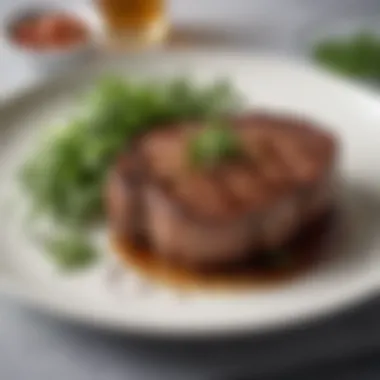
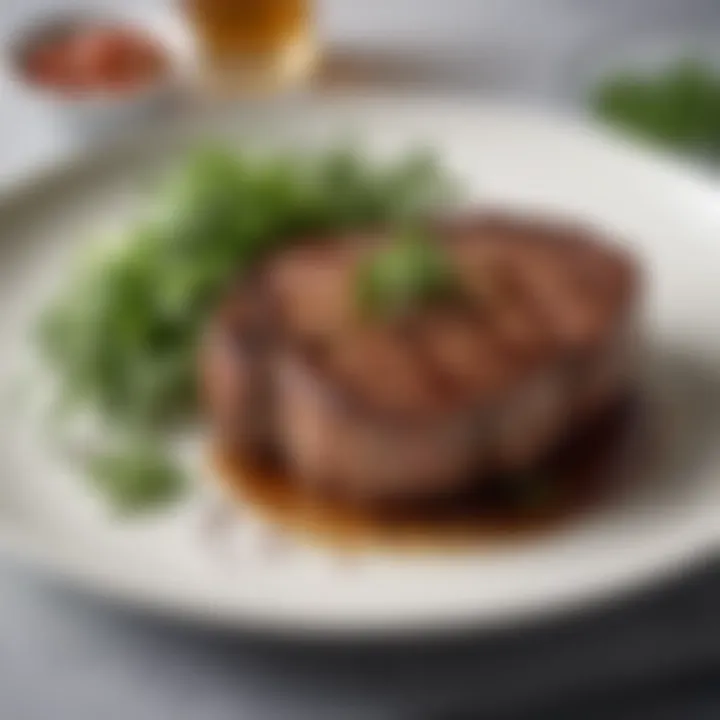
Through focus on these elements, you can take a simple ribeye steak and turn it into a memorable feast.
Enhancing Flavor Profiles
Enhancing the flavor profiles of a ribeye steak is not just about slapping on some seasoning and calling it a day. It's about crafting a symphony of tastes that bring out the best in the meat, complementing its rich, juicy character while elevating the entire dining experience. In this section, we will explore how the right combination of sauces and wines can turn a simple ribeye into a culinary masterpiece.
Pairing Ribeye with Complementary Sauces
When it comes to sauces, ribeye is remarkably versatile. It can handle rich and creamy sauces or tangy ones, depending on what flavor direction you want to take. Here are some options worthy of consideration:
- Chimichurri: This Argentine sauce is a delightful blend of parsley, garlic, vinegar, and olive oil. It cuts through the fat of the ribeye, adding a fresh, zesty contrast.
- Gorgonzola Cream Sauce: Creamy, cheesy, and savory, this sauce luxuriously blankets the steak for those who love a richer bite.
- Balsamic Reduction: A sweet and tangy drizzle can enhance the natural sweetness of the caramelized meat surface.
Each sauce has its unique appeal, but the key is balancing the flavors. For instance, a heavy, creamy sauce might be perfect for an evening dinner, while a vibrant, herbaceous chimichurri might be better suited for a summer barbecue. Remember, though, sauces are the final touch, so it’s best to allow the juicy, tender nature of the ribeye to shine through.
Choosing the Right Wine to Accompany
Selecting the right wine is another aspect of enhancing the overall flavor profile of ribeye. With its robust flavor, ribeye pairs splendidly with full-bodied red wines. Here are a couple that can create a match made in heaven:
- Cabernet Sauvignon: Known for its bold character, it boasts dark fruits and a hint of spice, which works beautifully with the steak’s richness.
- Malbec: Another excellent choice, Malbec offers juicy plum and blackberry notes with smooth tannins, perfectly complementing the buttery marbling of the ribeye.
When pouring wine alongside ribeye, think about temperature. Serving red wine slightly cooler than room temperature can enhance its characteristics and make the meal even more enjoyable.
The right sauce and wine can elevate the dining experience from ordinary to extraordinary, turning every meal into a memorable occasion.
Common Mistakes to Avoid
When it comes to mastering the art of cooking ribeye, there are pitfalls that can easily steer even the most eager cook off course. Understanding these common mistakes not only enhances your cooking skills but also guarantees that each ribeye steak turns out as exquisite as it should be. Avoiding these errors can mean the difference between a mediocre meal and a culinary triumph that impresses family and friends.
Overcooking: The Most Common Pitfall
One of the biggest blunders in cooking ribeye is the tendency to overcook it. This cut is known for its tenderness and rich flavor, which can quickly turn to a dry, tough bite if left on heat too long. The beauty of ribeye lies in its marbling, which melts and enriches the meat with juiciness when cooked correctly.
The ideal cooking time can vary depending on thickness, but a general rule is to remove the steak from heat when it reaches a few degrees below the desired doneness. A meat thermometer can serve as your trusty companion here. For instance, if aiming for medium-rare, pull it off the grill at around 130°F (54°C), as it will continue to rise in temperature while resting.
To avoid overcooking:
- Know your stovetop or grill: Each burns differently, so adjustments are often necessary.
- Develop a feel for timing: Practice helps gauge how long to cook each side.
- Stick to the right heat: High heat for searing is crucial, followed by lower heat for finishing.
Let's not beat around the bush; the texture of overcooked ribeye is a massive letdown, akin to chewing on rubber. Make it a priority to closely monitor the cooking process.
Underestimating Resting Time
After removing a ribeye from heat, many cooks make the mistake of slicing right in. Patience, however, pays off immensely. Resting the meat is essential for allowing the juices to redistribute throughout the steak. Slice into it too soon, and you'll be left with a lovely pool of juice on your cutting board instead of in the bite where it belongs.
Typically, a resting period of about 5 to 10 minutes should suffice, depending on the steak's size. Consider it an essential step in the cooking process, not just an afterthought.
During this time, it’s helpful to cover the ribeye loosely with foil to keep it warm without causing steaming, which could lead to a less desirable texture.
To maximize the benefits of resting:
- Use the time wisely: This can be a moment to finish side dishes or prep sauces.
- Avoid rush: Give the steak time to reach its full flavor potential.
In summary, both overcooking and underestimating resting time can lead to frustrating outcomes in ribeye preparation. Hence, awareness and practice are key components in becoming proficient in cooking this delightful cut.
Final Thoughts on Cooking Ribeye
As we tiptoe towards the conclusion, it becomes clear that cooking a ribeye steak is not merely about following a recipe; it's an intricate dance of flavors, techniques, and personal touches. The significance of this topic goes well beyond the plate. Understanding what makes the ribeye so special, from its marbling to cooking methods, can enhance your culinary prowess and elevate your confidence in the kitchen. By mastering the art of cooking ribeye, you’re not just honing a skill; you’re embarking on a delicious journey that allows you to create memorable meals that bring friends and family together.
Continuing the Culinary Journey with Ribeye
The beauty of cooking ribeye is how it continuously evolves. Each time you stand in front of that sizzling steak, there’s a whole world of possibilities to explore. This journey in the kitchen does not have to end with mastering the perfect sear. Dive into different seasonings, venture into pairing with unexpected side dishes, or challenge yourself with new cooking methods. Think of it as a never-ending quest; the seasoning blend that was a hit one week could be swapped for an intriguing marinade the next. Consider this:
- Experiment with spices from different cuisines, like smoky paprika or cumin, to introduce new bold flavors.
- Learn to make unique sauces, such as chimichurri or peppercorn sauce, that can amp up the flavor profile of your ribeye dish.
- Collaborate with seasonal vegetables to explore new textures and tastes.
These actions will not only deepen your connection with this cut but also broaden your culinary knowledge and skill set.
Exploring Variations of Ribeye Dishes
Ribeye can adapt to different culinary styles. From classic to contemporary, the versatility of this cut means there’s a ribeye dish for every occasion and flavor craving. Here are some variations that you might find inspiring:
- Ribeye Steak Tacos: Thinly slice cooked ribeye and serve in soft corn tortillas topped with zesty salsa and fresh cilantro.
- Ribeye Stir-Fry: Cut your steak into strips and toss it with vibrant veggies and a tangy soy sauce for an easy weekday meal.
- Sous Vide Ribeye with Garlic Butter: Use sous vide to perfectly cook your steak, then finish it off with a generous dollop of garlic butter. This method guarantees a tender and juicy outcome every time.
- Ribeye Salad: Top a hearty green salad with grilled ribeye slices for a healthy yet hearty meal.
"The magic of ribeye lies in its unrivaled flavor and the endless opportunities to innovate. Every cut tells a story."
Incorporating these ideas into your meal rotation can keep your dining experience fresh and exciting. As you cook, you’ll likely find that creating ribeye dishes is not just about sustenance; it’s about evoking emotion and creating bonds over shared meals. So, keep the grill hot and the knives sharp, as the adventure in ribeye cooking is just beginning.







